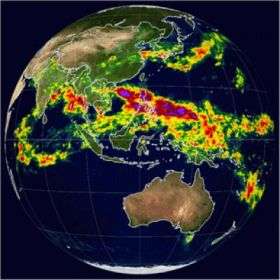Climate change: When it rains it (really) pours

Climate models have long predicted that global warming will increase the intensity of extreme precipitation events. A new study conducted at the University of Miami and the University of Reading (U.K.) provides the first observational evidence to confirm the link between a warmer climate and more powerful rainstorms.
One of the most serious challenges humanity will face in response to global warming is adapting to changes in extreme weather events. Of utmost concern is that heavy rainstorms will become more common and more intense in a warmer climate due to the increased moisture available for condensation. More intense rain events increase the risk of flooding and can have substantial societal and economic impacts.
To understand how precipitation responds to a warmer climate, researchers in this study used naturally-driven changes associated with El Niño as a laboratory for testing their hypotheses. Based on 20 years of satellite observations, they found a distinct link between tropical rainfall extremes and temperature, with heavy rain events increasing during warm periods and decreasing during cold periods.
"A warmer atmosphere contains larger amounts of moisture which boosts the intensity of heavy downpours," said Dr. Brian J. Soden, associate professor at the University of Miami Rosenstiel School of Marine & Atmospheric Science.
The report, "Atmospheric Warming and the Amplification of Precipitation Extremes," previewed in Science Express this Thursday, August 7, and published in an upcoming issue of Science, found that both observations and models indicated an increase in heavy rainstorms in response to a warmer climate. However, the observed amplification of rainfall extremes was found to be substantially larger in the observations than what is predicted by current models.
"Comparing observations with results from computer models improves understanding of how rainfall responds to a warming world" said Dr. Richard P. Allan, NERC advance fellow at the University of Reading's Environmental Systems Science Centre. "Differences can relate to deficiencies in the measurements, or the models used to predict future climatic change"
Source: University of Miami




















